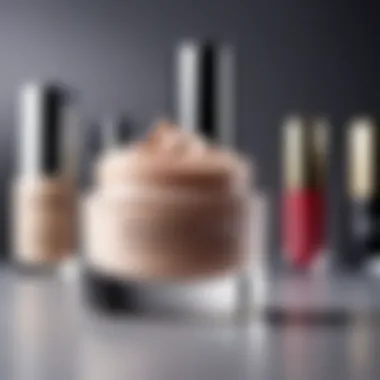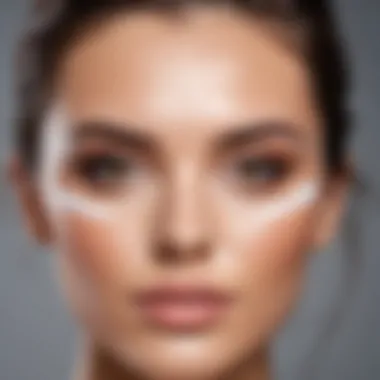Unlocking the Secrets of Makeup Primer


Intro
Makeup primers are often seen as optional by many, but they play a crucial role in crafting a polished makeup look. Understanding what makeup primers are and their purpose can transform your makeup routine. These products often lie at the intersection of skincare and cosmetic application. Knowing how they work can significantly enhance the longevity and appearance of makeup.
This article will break down the essentials of makeup primers, including the different types available and their benefits. It will also offer guidance on how to select the right primer based on individual skin types and concerns. Furthermore, mastering the application techniques ensures you get the most out of your makeup products.
In this space, beauty enthusiasts can unlock the secrets behind a flawless finish, catering not just to women but to men of all ages who seek to enhance their aesthetic presentation.
Prolusion to Makeup Primer
Makeup primer has gained significant attention in recent years, evolving from a niche product to a staple in many beauty routines. Understanding its purpose is crucial for anyone who wants to achieve a polished and lasting makeup look. Primers function as a preparatory step, acting as a barrier between the skin and makeup, aiming to enhance the overall appearance while addressing specific skin concerns. In this section, we will elaborate on the essential roles primers play in makeup application, dissecting their benefits and considerations.
What is Makeup Primer?
Makeup primer is a cosmetic product designed to create an even canvas for makeup application. It is typically applied after skincare but before applying foundation or any other makeup. Various formulations exist, catering to different skin types and needs. Most primers contain silicone or water-based ingredients, which help smooth out imperfections, minimize the appearance of pores, and ensure that foundation adheres better to the skin.
The primary goal of a makeup primer is to enhance the longevity of makeup. When applied correctly, it can contribute to a smoother finish and can also help control shine, depending on its formulation. By filling in fine lines and texture, a good primer can give the skin a refined look, allowing makeup to not only last longer but also appear fresher throughout the day.
Historical Context of Makeup Primers
The history of makeup primer is intertwined with the evolution of cosmetic products. While the use of paint and color on faces dates back to ancient civilizations, the concept of a primer is relatively modern. Early makeup rituals focused on achieving a desired look without the sophisticated layering we have today.
The first modern primers emerged in the late 20th century, primarily as a response to changing makeup trends. The introduction of silicone-based formulations in the 1990s marked a turning point, offering consumers improved texture and application ease. Over the years, as consumers became more knowledgeable about skincare and makeup science, the demand for specific functionalities in primers grew. Today, the market is saturated with options, each promising unique benefits tailored to various skin types and concerns.
In recent years, makeup primers have evolved further, incorporating skin-benefiting ingredients like antioxidants and hydrators. This evolution reflects a broader trend in the beauty industry, where the focus is as much on skin health as it is on makeup aesthetics. By understanding both the definition and historical significance of makeup primers, consumers can better appreciate their role in a comprehensive beauty routine.
The Purpose of Makeup Primer
Makeup primer serves several crucial roles in the makeup application process. The importance of understanding primers is relevant as they act as a foundational step. By preparing the skin, they establish an optimal base for further makeup, ensuring better adherence and a smoother finish. Exploring the purpose of makeup primer reveals its multifaceted benefits, which can greatly enhance one’s beauty routine.
Enhancing Makeup Longevity
One of the primary functions of makeup primer is to enhance the longevity of makeup. Makeup can easily fade or smudge throughout the day due to various environmental factors such as humidity, sweat, and oil production. Using a quality primer helps to form a barrier between the skin and makeup products. This not only prevents makeup from settling into fine lines but also reduces the chances of it wearing off. In many cases, a primer can extend the wear of foundation, blush, and eye products significantly. A simple application of a primer can mean the difference between makeup needing a touch-up within hours or lasting well into the night.
Smoothing Skin Texture
Another critical aspect of makeup primer is its ability to smooth the skin’s texture. Many primers contain ingredients that fill in pores, fine lines, and uneven skin surfaces. This smoothing effect enables foundation and other makeup products to glide on effortlessly. The result is a more polished and refined appearance. In essence, a good primer prepares the skin by creating an even plane. As a result, the makeup looks more professional and aesthetically pleasing. It mitigates issues such as patchiness or uneven application, allowing for a more seamless finish.
Balancing Skin Tone
Makeup primers also play a significant role in balancing skin tone. Some primers are formulated with color-correcting properties that can neutralize redness or dullness in the skin. For instance, green primers can counteract redness, while lavender can brighten sallow complexions. Using a color-correcting primer not only enhances the skin’s natural appearance but also reduces the amount of foundation or concealer needed for even coverage. This targeted approach helps create a more harmonious canvas for makeup application, making it easier to achieve the desired look.
"Using a makeup primer is often the unsung hero of a successful makeup routine. It not only extends wear time but also improves the overall finish of makeup."
Types of Makeup Primers
Understanding different types of makeup primers is crucial for anyone looking to enhance their makeup routine. Each primer type serves distinct purposes and provides unique benefits based on skin types and specific needs. Knowledge of these variations helps individuals make informed choices, ensuring they select the right one for their particular situation. The following sections will delve into five main types of makeup primers: silicone-based primers, water-based primers, oil-based primers, hydrating primers, and matte primers.
Silicone-Based Primers
Silicone-based primers are among the most popular choices for many users. These primers often contain ingredients like dimethicone, which creates a smooth, velvety texture on the skin. The primary advantage of silicone primers is their ability to fill in fine lines, pores, and imperfections, resulting in a noticeably smoother surface. They help in achieving an airbrushed look, allowing for seamless makeup application.
However, it is important to note that silicone-based primers might not be suitable for everyone. Those with oily or sensitive skin can experience breakouts or irritation after use. Thus, it is essential to test a small area before application on the entire face.
Water-Based Primers
Water-based primers are designed for individuals seeking a lightweight option. They usually contain water as a primary ingredient and are ideal for those with normal to oily skin. These primers offer a refreshing feel and can help in hydrating the skin without adding excess oil.


One key benefit of water-based primers is their ability to allow makeup to adhere well without weighing it down. They can also work effectively with water-based foundations, which is a common choice for many users. However, people with very dry skin may find these primers lacking in moisture, leading to potential dryness during the day.
Oil-Based Primers
Oil-based primers provide an option for individuals with very dry or mature skin. These primers contain different oils that help in hydrating the skin while creating a barrier to lock in moisture. The result is a dewy, luminous finish that can enhance a more natural makeup look.
The downside of oil-based primers is that they can feel heavier than other types. If used in excess, they might lead to a more oily appearance, especially on those with combination or oily skin. It's advisable to use oil-based primers sparingly for optimal effect.
Hydrating Primers
Hydrating primers, as the name suggests, focus on moisture. They are formulated with skin-loving ingredients like hyaluronic acid and glycerin. These components attract moisture to the skin, making them an excellent choice for dry or dehydrated skin types. Hydrating primers can revitalize a dull complexion and help makeup sit beautifully on the skin.
In addition to providing hydration, these primers can create a smooth base for foundation, ensuring a flawless application. They also minimize the appearance of dryness and flakiness, making them essential in colder months when skin tends to require more moisture.
Matte Primers
For those with oily skin or those who prefer a matte finish, matte primers are the best choice. They work to absorb excess oil, helping to control shine throughout the day. Ingredients like silica are often included in their formulation to achieve this oil-absorbing effect.
Matte primers can create a smooth foundation for makeup, extending its wear time. However, those with dry skin should be cautious, as these primers can sometimes exacerbate dryness and make the skin appear flaky. Choosing the right primer is essential based on individual skin conditions to avoid potential issues.
Selecting the right type of primer can significantly influence the effectiveness and longevity of your makeup. Each type serves unique benefits, thereby catering to various needs and preferences in the cosmetic application process.
Choosing the Right Primer for Your Skin Type
Selecting the appropriate makeup primer is vital for achieving the desired finish, longevity, and overall effectiveness of makeup applications. Each person's skin can vary widely in texture, oiliness, and hydration levels. Therefore, understanding one's skin type and concerns becomes the foundation for making informed decisions about primer selection. Applying the wrong product can lead to uneven makeup, excessive shine, or dryness, affecting not only aesthetic results but also skin health.
Moreover, some makeup primers contain specific active ingredients that can improve skin health over time. Using a primer that complements your skin type can also enhance your makeup experience, leading to better application and prolonged wear. It is essential to evaluate skin condition and identifies personal preferences.
Understanding Your Skin Type
The first step in choosing a primer is to accurately determine your skin type. The common classifications include:
- Oily Skin: This skin type typically appears shiny, especially in the T-zone (forehead, nose, and chin). Individuals with oily skin often experience makeup sliding off throughout the day.
- Dry Skin: Characterized by flakiness or tightness, dry skin may struggle with makeup adherence. A suitable primer can provide moisture and prevent foundation from clinging to dry patches.
- Combination Skin: This starting point indicates varying skin conditions across different areas. Understanding the specific needs of each area is crucial.
- Normal Skin: Balanced and smooth, normal skin generally doesn't require much rectification but may benefit from products that enhance make-up longevity.
Recognizing one’s skin type helps in selecting a primer that either controls excess oil, adds moisture or balances different areas of the face. Knowing the specific characteristics will direct users toward products formulated to address their unique needs.
Recommendations Based on Skin Concerns
Once skin type is established, look for relevant primer recommendations based on specific concerns that might arise. Some common skin concerns include:
- Acne: Choose makeup primers that are non-comedogenic and oil-free. Products containing salicylic acid may help with skin clarity.
- Enlarged Pores: Silicone-based primers can work wonders for smoothing the appearance of large pores, providing a blurring effect that helps the makeup sit better.
- Fine Lines: For mature skin, hydrating primers can plump the skin and create a smooth canvas that minimizes the look of fine lines.
- Sensitivity: Individuals with sensitive skin should look for fragrance-free and hypoallergenic formulations to reduce the risk of irritation.
In addition:
- Always perform a patch test when trying new products.
- Consider consulting with a dermatologist for personalized recommendations, especially if you have specific skin conditions.
Choosing the right primer ensures that makeup applies evenly and that the final look is polished and maintained throughout the day. By tailoring choices to skin type and addressing specific concerns, individuals can significantly improve their cosmetic experience.
How to Effectively Use Makeup Primer
The effective use of makeup primer significantly influences the overall makeup experience. It serves as a bridge between skincare and makeup application, providing a comprehensive foundation upon which makeup can perform better. Proper application techniques and preparation can enhance the longevity and finish of your makeup. Understanding how to utilize primer effectively can lead to a more polished look, directing attention to the specific benefits outlined in this section.
Preparation Before Application
Before applying makeup primer, it is crucial to prepare the skin. First, ensure that your face is clean and moisturized. A clean face allows the primer to adhere better and smoother. Following cleansing, applying a moisturizer helps to hydrate the skin. This step is vital as it provides a base for the primer and contributes to a more even makeup application.
Furthermore, consider using sunscreen if you are going outside. This will not only protect your skin from harmful rays but also help makeup to last longer throughout the day.


Application Techniques
Making choices about application techniques can determine how effective the primer will be. Here are three popular methods:
Dabbing with Fingers
Dabbing with fingers is a straightforward technique for applying makeup primer. This method allows warmth from your fingers to help the product meld with the skin. The key characteristic of this approach is its accessibility; anyone can do it, making it a popular choice.
Advantages of Dabbing with Fingers:
- Control: You can control how much product is used and where it goes.
- Blendability: The warmth of fingers aids in blending the product seamlessly into the skin.
Disadvantages of Dabbing with Fingers:
- Hygiene: Fingers can carry bacteria, which may not be suitable for all skin types.
Using a Brush
Using a brush for primer application provides a more professional feel. Brushes can ensure an even coating of primer. The key characteristic of this method is precision. Brushes come in various shapes and sizes, allowing for targeted application.
Advantages of Using a Brush:
- Even Coverage: A brush helps to distribute the product evenly across the surface.
- Less Product Absorption: Brushes do not absorb as much product as fingers might.
Disadvantages of Using a Brush:
- Cleaning: Brushes require regular cleaning, which adds to the maintenance routine.
Employing a Sponge
Employing a sponge is another effective technique, particularly for those looking for a light application. This method creates a soft finish, as the sponge can soften the appearance of the primer on the skin. The key feature of this technique is its ability to give a “second-skin” look, enhancing the natural appearance.
Advantages of Employing a Sponge:
- Blendable Results: Sponges can create a seamless blend, allowing the primer to appear more natural.
- Versatility: Sponges can be used for all types of makeup products.
Disadvantages of Employing a Sponge:
- Product Absorption: Sponges may absorb some primer, which can lead to increased product usage.
Drying Time Considerations
After applying the primer, allowing it adequate drying time is important before applying foundation or other makeup products. Different formulations of primers have varied drying times. Silicone-based primers tend to dry quickly, whereas hydrating primers may take a bit longer. Not allowing sufficient time may result in makeup that does not adhere properly, causing it to wear off sooner.
Common Mistakes in Primer Application
Understanding common mistakes in primer application is crucial for achieving desired makeup results. Many individuals overlook the significance of preparation and technique when using makeup primer, which can lead to subpar results. By recognizing and addressing these mistakes, one can ensure that makeup appears flawless and lasts longer. The process of applying primer is not just about putting on a layer of product; it requires careful consideration of texture, quantity, and skin condition.
Using Too Much Product
Using too much makeup primer is a frequent error and it compromises the overall look. A common misconception is that more product will yield better results, but this is often counterproductive. When excess primer is applied, it can create a thick barrier on the skin that disrupts the natural blend of other makeup products. This may lead to makeup separating or sliding off during the day.
Best Practices:
- Start Small: Begin with a pea-sized amount. This allows for a more controlled application and prevents waste.
- Build Gradually: If necessary, add a little more product after assessing the initial application. This helps in achieving the right coverage without overwhelming the skin.
- Focus on Key Areas: Prioritize application on areas where makeup typically fades faster like the T-zone or around the eyes.
Neglecting Skin Care Preparation


The importance of skin care preparation before applying primer cannot be overstated. Neglecting this step often results in uneven application and reduced effectiveness of the primer. Clean, moisturized skin provides a suitable canvas for primer, enhancing its ability to smooth and unify skin texture.
Additionally, different skin types require corresponding care routines. Oily skin, for instance, should utilize mattifying products, while dry skin needs hydration to ensure that the primer adheres well without clinging to dry patches.
Recommendations:
- Cleansing: Always start with a clean face to remove dirt and oils that can affect primer performance.
- Moisturizing: Apply a suitable moisturizer according to skin type. This ensures that the skin is hydrated, which aids in the smooth application of primer.
- Let Products Absorb: Allow time for skin care products to fully absorb before applying primer. This will help achieve a more seamless finish.
"A well-prepared base improves makeup application and longevity significantly. Consider this step the foundation of your makeup routine."
In summary, avoiding these common mistakes ensures that primer serves its intended purpose effectively. By using an appropriate amount of product and preparing the skin adequately, individuals can maximize the benefits of their makeup primer.
The Impact of Primer on Makeup Finish
Makeup primers serve an essential role in shaping the final appearance of makeup. They create a smooth canvas and affect the overall finish of the makeup. Understanding this impact is crucial for individuals who seek a polished look that lasts.
Achieving an Airbrushed Look
Primers can significantly contribute to an airbrushed effect in makeup application. When used correctly, a good primer helps to fill in fine lines, pores, and uneven skin textures. In this sense, it acts almost like a professional filter, leveling the skin’s surface. The smooth layer it provides allows foundation and concealer to glide on evenly, resulting in a seamless blend.
For optimal results, choose a primer that caters to your skin type. For example, pore-filling primers are beneficial for those with oily or combination skin, as they minimize the visibility of pores. Hydrating primers do well for dry skin types, ensuring that the foundation does not cling to dry patches. The choice of primer is crucial in establishing a flawless finish that resembles airbrushing or airbrushing-style results.
"A quality primer paired with the right foundation can create a result that looks professionally done."
Controlling Shine and Oiliness
Another important function of makeup primers is the ability to control shine and oiliness throughout the day. Oily skin types often struggle with makeup that tends to break down or slide off by midday. Here, a mattifying primer can be an effective solution. These primers absorb excess oil and keep the makeup intact, ensuring a fresh appearance from morning till night.
Additionally, the finish of the makeup largely depends on the primer used. A mattifying primer helps to produce a non-glossy look, which is preferred by many. In contrast, illuminating primers can give a dewy, healthy glow, ideal for a more luminous finish. Therefore, when selecting a primer, consider your skin type and the desired look. This thoughtful choice will help control unwanted shine, leaving you with a balanced and appealing makeup finish.
In summary, the impact of primer on the makeup finish is significant. It not only smooths the skin and enhances longevity but also supports achieving specific aesthetic goals, be it a polished airbrushed look or a matte finish.
Makeup Primer and Skin Health
Makeup primer serves a significant role not only in enhancing the application of cosmetics but also in promoting skin health. A well-chosen primer can create a barrier between makeup and skin, which helps minimize the potential negative effects of cosmetic use. Understanding this aspect adds depth to the discussion about the overall benefits of primers.
Benefit from Active Ingredients
Many contemporary makeup primers are infused with active ingredients that cater to various skin concerns. For instance, primers with hydrating components, such as hyaluronic acid, can provide moisture and ensure the skin appears plump and healthy. Additionally, those featuring antioxidants, like vitamin C and E, may help protect skin cells from free radicals, reducing signs of aging.
Some primers include soothing agents like aloe vera or chamomile, which can calm inflammation. This makes them suitable for sensitive skin types. When selecting a primer, it is crucial to scrutinize the ingredient list. Choosing a primer that works with your skin’s specific needs can significantly improve not only how makeup applies but also how the skin looks and feels throughout the day.
Long-Term Effects of Primer Use
Using makeup primer consistently can lead to long-term benefits for the skin. Primers can help balance oil production, leading to fewer breakouts and a more refined texture over time. This becomes particularly relevant for individuals with oily or combination skin, as the right primer can help maintain control over excess shine without clogging pores.
Furthermore, extended use of primers that include skin-friendly ingredients may enhance skin hydration. Over time, this can contribute to improved elasticity and resilience in the skin. Users may notice that their skin is not only reacting better to makeup but is also healthier, creating a more vibrant appearance even without makeup.
"Choosing the right makeup primer is not just about improving cosmetic results; it is also about nurturing the skin beneath."
Ending
Makeup primer serves as a foundation for a flawless makeup experience. Its importance cannot be overlooked as it significantly raises the quality of any subsequent cosmetic application. Understanding primer's multifaceted roles allows users to fully leverage its benefits, leading to a makeup approach that enhances both durability and appearance.
Summarizing the Importance of Primer
In summary, makeup primer acts as a bridge between skin care and cosmetic application. It allows for better adherence of makeup, reduces the appearance of imperfections, and contributes to a smoother texture. Additionally, with the right primer, individuals can ensure that their makeup withstands the demands of their daily life. This effectiveness is not just about aesthetics; it also plays a vital role in boosting confidence. The psychological impact of feeling put together cannot be understated. By incorporating primer into their routine, users can elevate their overall makeup experience.
Emphasizing Tailored Choices
Emphasizing tailored choices in makeup primer selection is crucial. Each skin type presents unique needs, and the right primer can make a significant difference. For oily skin, a matte primer can control shine, whereas a hydrating primer benefits those with dryness. It is advisable for users to consider factors like skin texture, sensitivity, and personal preferences.
Moreover, experimenting with different formulations may lead to discovering what works best for the individual. In choosing wisely, one ensures not only a better makeup result but also healthier skin over time.















